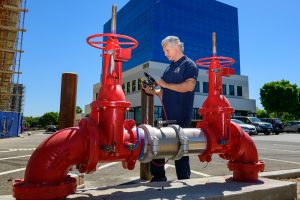 State regulations require that residential, commercial and industrial customers served by a public water system take adequate measures to protect the public water system from potential contamination. Under certain conditions, water from private plumbing can flow into the public water distribution system. This is referred to as backflow. Here’s what you need to know.
State regulations require that residential, commercial and industrial customers served by a public water system take adequate measures to protect the public water system from potential contamination. Under certain conditions, water from private plumbing can flow into the public water distribution system. This is referred to as backflow. Here’s what you need to know.
What is backflow?
Backflow is the reverse flow of water or other substances into the treated drinking water distribution system. There are two types of backflow: (1) backpressure and (2) backsiphonage.
Backpressure happens when the pressure of the contaminant source exceeds the positive pressure in the water distribution main. An example would be when a drinking water supply main has a connection to a hot water boiler system that is not protected by an approved and functioning backflow preventer. If pressure in the boiler system increases to where it exceeds the pressure in the water distribution system, backflow from the boiler to the drinking water supply system may occur.
Backsiphonage is caused by a negative pressure (vacuum or partial vacuum) in the water distribution system. This situation is similar in effect to the sipping of water through a straw. In the drinking water distribution system, negative pressure (backsiphonage) occurs during a water main break or when a hydrant is used for firefighting.
What is cross-connection?
Cross-connection is any actual or physical connection between a potable (drinkable) water supply and any source of non-potable liquid, solid or gas that could contaminate drinking water under certain circumstances.
Why should you be concerned?
Backflow may affect the quality of the drinking water at your home or business and has the potential to create health hazards if contaminated water enters your water supply plumbing system and is used for drinking, cooking or bathing.
Unprotected cross-connections with water supply plumbing or public drinking water piping systems are prohibited.
Who is responsible?
We are all responsible for protecting our water supply from backflow that may contaminate our drinking water. This includes complying with the plumbing code and avoiding unprotected cross-connections.
State and local plumbing inspectors typically have authority over plumbing systems within buildings while state regulatory agencies and public water suppliers regulate protection of the distribution system at each service connection.
Water customers have the ultimate responsibility for properly maintaining their plumbing systems. It is their responsibility to ensure there are no unprotected cross-connections and that any required backflow prevention devices are tested in accordance with state requirements and maintained in an operable condition.
How do I submit a backflow test report?
The City of Santa Ana has recently established a new online platform—the SwiftComply portal—to submit backflow test reports.* Our goals in implementing this software solution include improved compliance, more timely processing of test results, and reduced administrative burden.
Starting September 20, 2023, backflow test reports will no longer be accepted by email, mail, fax or any other form except through the SwiftComply portal.
While the SwiftComply portal will not be available for test entries until October 1, 2023, we encourage backflow testing companies to enroll in advance to learn the new system. Enrolling is easy by clicking here.
From the enrollment page you may:
- Request an Admin style account
- Request individual Tester accounts
- Submit your Testing Certification and Test Kit Information (Please note these are required to sign up)
- View Frequently Asked Questions
SwiftComply charges a $5 fee per test. This fee only applies to passing tests. There is no charge for failed tests.
For any questions or inquiries, please email backflow@santa-ana.org.
*Tests must be performed by a backflow prevention device tester certified by the Orange County Health Care Agency and has a valid City of Santa Ana Business License.
How can I prevent backflow?
- Be aware of cross-connections, eliminate or isolate them.
- Maintain air gaps on sinks and when using hoses.
- Do not submerge hoses or place them where they could become submerged.
- Use hose bib vacuum breakers on fixtures (hose connections in the basement, laundry room, and on outside faucets/spigots).
- Install approved backflow prevention devices on lawn irrigation systems and on fire sprinkler system services. Type of required backflow prevention devices will be determined based on the potential type of pollutants or contaminants; high, low or moderate.
